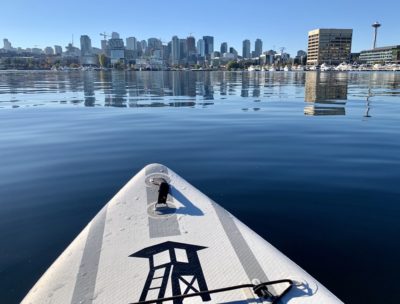The sun is shining and for many of us that means longer days to spend outside doing what we love. In Seattle we have many options for outdoor activities to stimulate out bodies and minds. One great summer activity that gets us out on the water and is fun, is stand up paddle boarding (SUP). SUP is a water sport where, much like surfing, you stand on a long but thicker and wider board, and use a long paddle and propel yourself on the water. It involves balancing with your legs and feet, and using your core and upper body to help you move forward in the water while standing.
 The first thing I want to discus in regards to SUP is safety, because you want to make sure you are prepared before you get out on the water. I have a small list to get your started, but this link has a more in depth list if you prefer.
The first thing I want to discus in regards to SUP is safety, because you want to make sure you are prepared before you get out on the water. I have a small list to get your started, but this link has a more in depth list if you prefer.
- Wear a life jacket with a whistle
- Start in calm waters and avoid a windy day and avoid areas with high motorized traffic. So check the weather and dress appropriately
- Wear a leash. This is what keeps you connected to your board if you happen to fall.
- If planning to SUP alone bring your phone and let someone know where you will be.
Another thing to remember is that motorized boats and sail boats often have the right away and it is best to stay along the coast if you find yourself in a high traffic zone. It may be best to avoid sunrise and sunset times as they can be the times it is the hardest to see. Bring a dry bag with food and water and sunscreen if you plan on being out for a while. Also, start on your knees when leaving the dock and stay on your knees if standing seems intimidating at first.
SUP has increased in popularity over the years as an easy and fun sport that lets us explore the outdoors by way of water. It is great for all ages and can be enjoyed on lakes, rivers, oceans, and bays. SUP has been shown to lead to an increase in better aerobic and anaerobic fitness which can lead to improved cardiovascular fitness. By working the whole body through isometric strengthening of the entire trunk, gluteals, and lower leg muscles to resist the pulling motion as well as the upper back, and arms and shoulders to perform the pulling and digging of the paddle in the water (Schram, Hing, & Climstein, 2016). Don’t worry you can paddle as slow or as fast as you would like!
A study by Schram, Hing, and Climstein (2016) suggested that, The fact that many physiological, musculoskeletal and psychological benefits can be obtained from participation places SUP as an ideal option for those who are time limited and still looking to improve strength and fitness. Due to it being accessible, relatively easy to learn and low impact on the joints is also of great benefit. The obvious psychological benefits and enjoyment obtained from this activity delivers an alternate means of aerobic, anaerobic and strength training than the traditional methods.
So get out there, have fun, and please be safe! And to learn more about safety and body mechanics with SUP, schedule online with Jane Hosman, PT, DPT at mobilizept.com
References:
Schram, B., Hing, W., & Climstein, M. (2016). The physiological, musculoskeletal and psychological effects of stand up paddle boarding. BMC sports science, medicine & rehabilitation, 8, 32. doi:10.1186/s13102-016-0057-6
 The first thing I want to discus in regards to SUP is safety, because you want to make sure you are prepared before you get out on the water. I have a small list to get your started, but this link has a more in depth list if you prefer.
The first thing I want to discus in regards to SUP is safety, because you want to make sure you are prepared before you get out on the water. I have a small list to get your started, but this link has a more in depth list if you prefer.
